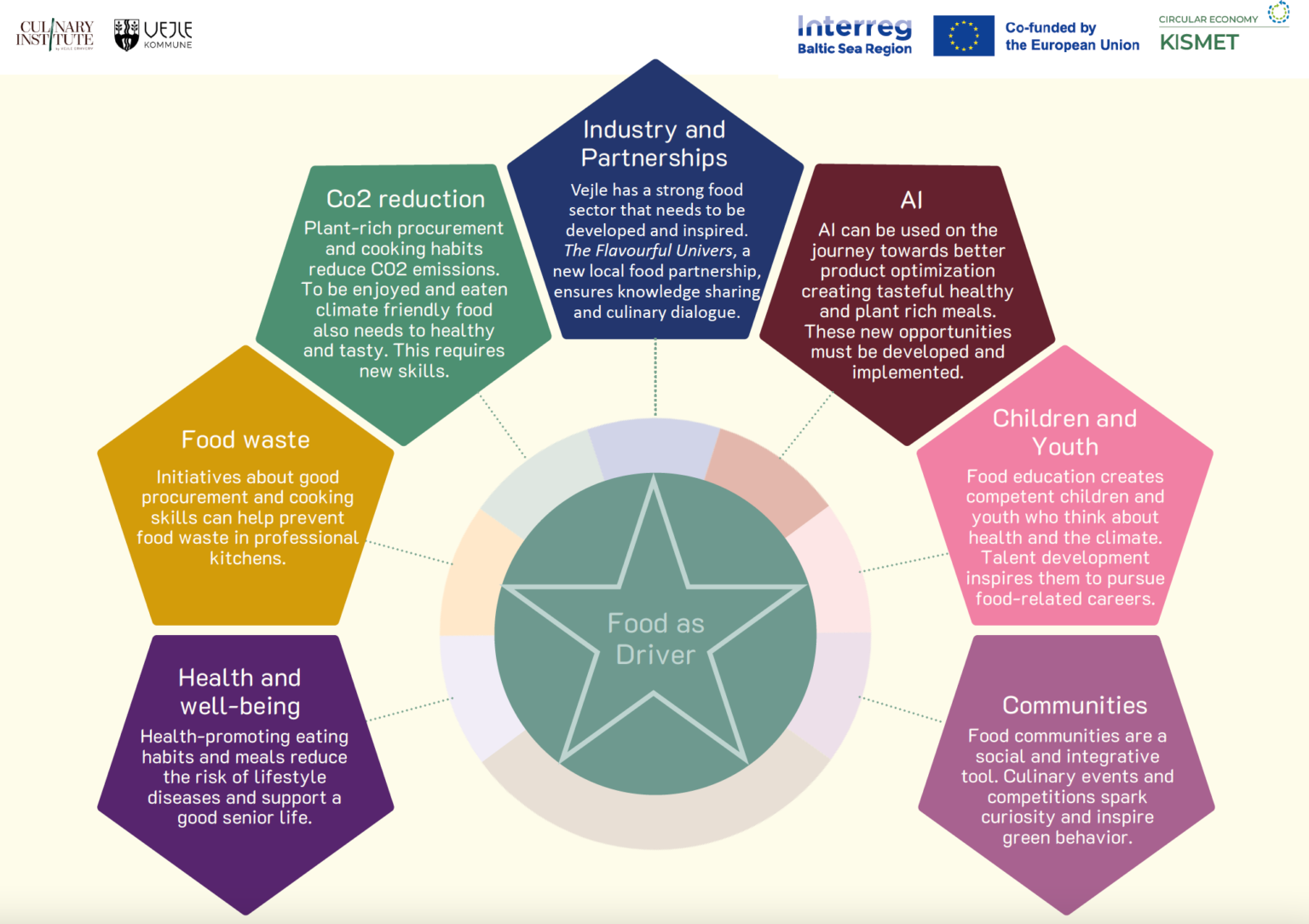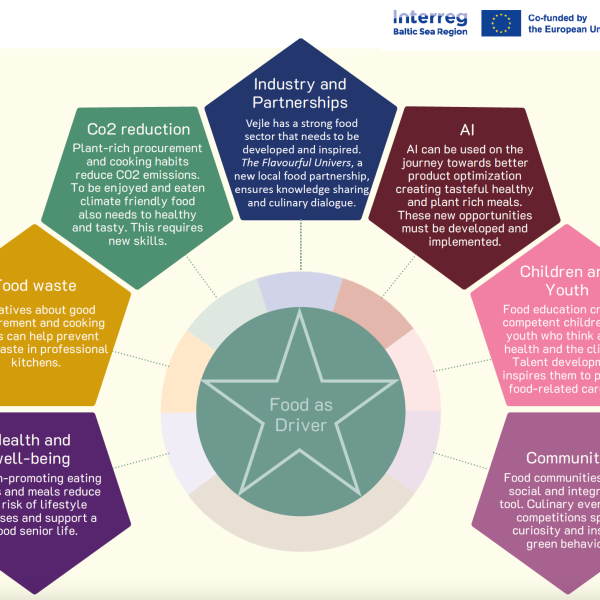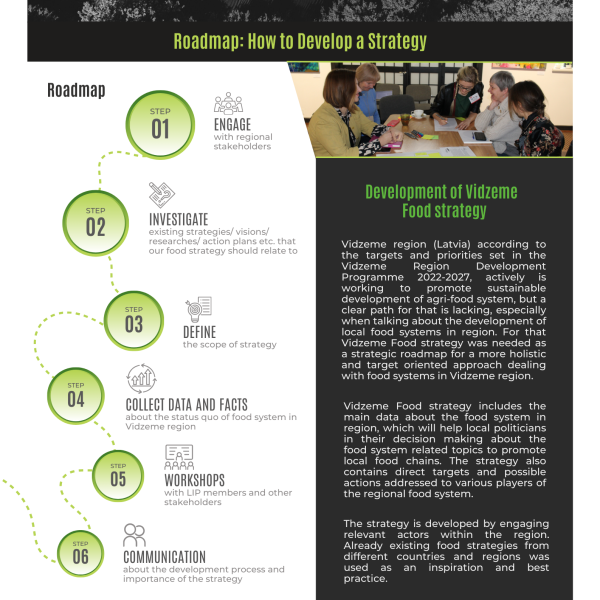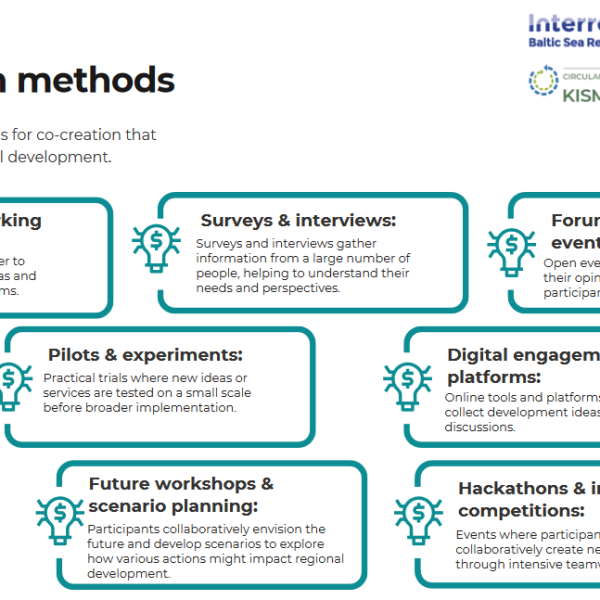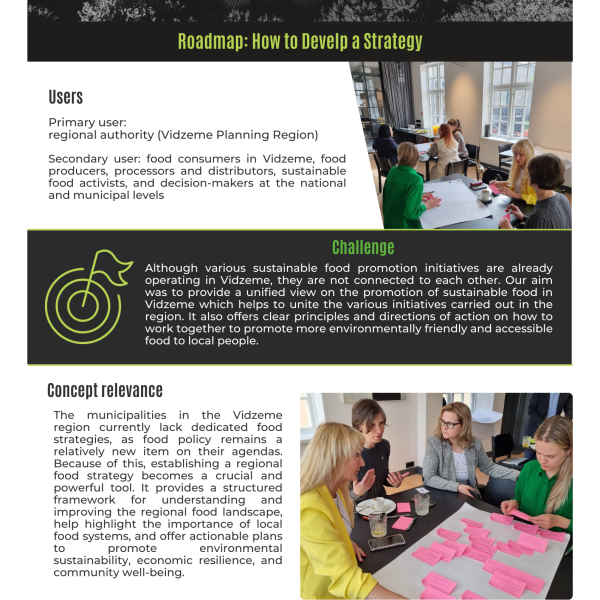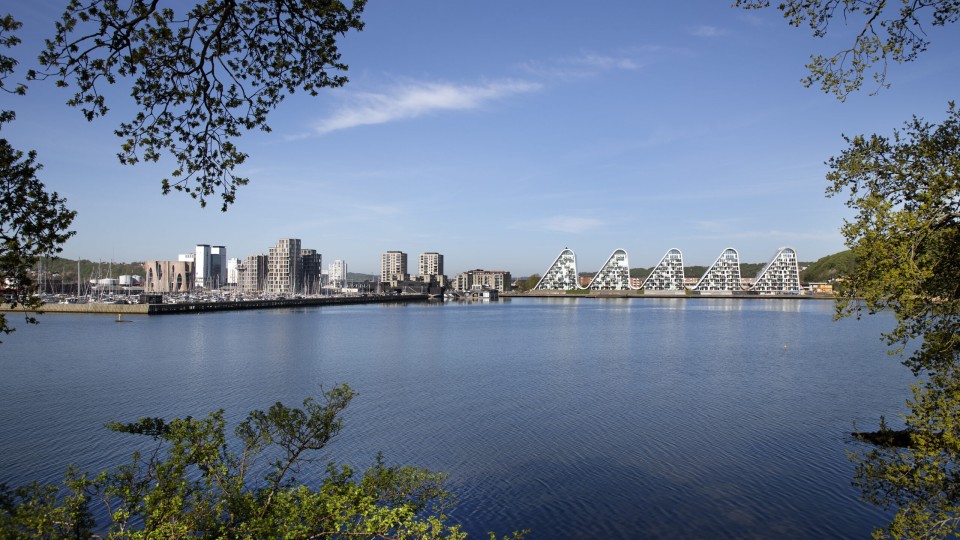A successful food strategy requires input and commitment from a wide range of people. Close collaboration with relevant actors throughout the food system is essential to support these efforts. Unlike traditional top-down approaches, which can overlook key stakeholders in the food industry, a co-creation process actively involves them in shaping the strategy. This model ensures that the final plan aligns with the needs and expectations of those directly affected by it.
The focus of this concept is to provide a different set of actions to develop a user-centred co-creation model that engages stakeholders such as developers, producers and entrepreneurs. By involving diverse perspectives and determining key roles throughout the plan, this approach offers a way to foster shared understanding, and ownership of the food strategy. Importantly, the strategy process should include examples of practical implementation and give concrete examples of already existing actions that help meet the vision, ultimately building a strong foundation for putting it into action.
How to do it
Suggested actions
- Collaborate with relevant actors in your organisation using the quadruple helix model.
- Assess existing strategies within your organisation to align with your food strategy.
- Seek inspiration from industry best practices in food strategies.
- Map relevant actors and determine engagement methods, such as workshops.
- Develop a framework to measure the impact of your food strategy.
- Engage stakeholders from the food industry in a user-centred co-creation model.
- Showcase existing actions contributing to the food strategy vision.
- Investigate funding and policy support for implementation.
- Coordinate workshops, roundtables, or individual meetings to involve stakeholders.
- Create an action plan based on investigations, stakeholder engagement, and strategy mapping.
Local adaptations
South Savo, Finland
With this concept, South-Eastern Finland University Applied Sciences, XAMK, created an action plan for creating a more sustainable food environment. They used existing guidelines and strategies as the structure of the action plan. The action plan was developed using a co-creation model: A Co-Creation Model for Regional Development in the Food Sector. Co-creation involves the active participation of various stakeholders in the development process, such as residents, businesses, the public sector, and organizations. In regional development, co-creation ensures that develop-ment projects meet the needs and desires of the local population. Co-creation fosters innovative solutions, increases commitment, and enhances the acceptance of development projects, leading to more sustainable and effective out-comes. To build the action plan, XAMK employed co-creation methods, specifically workshop activities, where stake-holders gathered to collaboratively develop ideas and solutions for the structure of the action plan. In addition, a pre-liminary survey was conducted among stakeholders before the workshop to gather sufficient background material for the workshop framework.
Hamburg, Germany
In Hamburg relevant actors to implement a food strategy and proper financial and/or policy support are identified. The activities include building a political and scientific network, setting up roundtables, and coordinating individual meetings with stakeholders.
Vejle, Denmark
Culinary Institute by Vejle Erhverv is developing an action plan targeting several strategic focus areas. The plan, named ‚Mad som motor‘ or ‚Food as Driver,‘ underscores the significant role of food as a catalyst for change.
As the foundation of this document, the Culinary Institute has invited various stakeholders from both within and out-side the municipality to identify existing actions and projects, as well as to explore potential new collaborations relat-ed to food. The document is a “living” document that will be updated continuously with new actions and ideas.
Food and nutrition professionals, local chefs, and food producers play key roles in this action plan. There is a strong emphasis on promoting plant-rich foods, reducing food waste, supporting local seasonal produce, and exploring new AI solutions. This approach ensures that the action plan considers food in relation to climate, health, circularity, and supports local food production, contributing to a sustainable food environment.
Vidzeme, Latvia
Vidzeme Planning Region has created a strategic guideline “Sustainable food system of Vidzeme 2035”. It includes main data about the food system in the region, which will help local politicians in their decision making about the food system topics. Strategic guidelines outline vision, aims and strategic directions as well as possible actions towards more sustainable regional food system. The document was developed by involving various stakeholders.
KISMET Actions & Tools
Co-creation model for regional development (South Savo)
With this concept, South-Eastern Finland University Applied Sciences, XAMK, created an action plan for creating a more sustainable food environment. They used existing guidelines and strategies as the structure of the action plan. The action plan was developed using a co-creation model: A Co-Creation Model for Regional Development in the Food Sector. Co-creation involves the active participation of various stakeholders in the development pro-cess, such as residents, businesses, the public sector, and organizations. In regional development, co-creation en-sures that development projects meet the needs and desires of the local population. Co-creation fosters innova-tive solutions, increases commitment, and enhances the acceptance of development projects, leading to more sustainable and effective outcomes. To build the action plan, XAMK employed co-creation methods, specifically workshop activities, where stakeholders gathered to collaboratively develop ideas and solutions for the struc-ture of the action plan. In addition, a preliminary survey was conducted among stakeholders before the work-shop to gather sufficient background material for the workshop framework.
“Mad som motor” (Vejle)
„Food as Driver“ (Mad som motor) is an action plan addressing several strategic focus areas. It is designed as a dynamic, living document that evolves continuously, incorporating new actions and projects as they are pro-posed or implemented.
Strategic guidelines "Sustainable food system of Vidzeme 2035" (Vidzeme)
The developed strategy guidelines provide a structured framework for understanding and enhancing the re-gional food landscape. They emphasize the significance of local food systems and present actionable plans to promote environmental sustainability, economic resilience, and community well-being. The strategic guide-lines, „Sustainable Food System of Vidzeme 2035,“ were created through a co-creation process involving ap-proximately 170 stakeholders across four workshops.
A preliminary version is available for download below. The finalised version of the strategic guidelines will be added soon.
Related knowledge
EIT Food Strategic Agenda 2021-2027
The Strategic Innovation Agenda 2021-2027 outlines the strategy and priorities of the European Institute of Innova-tion and Technology (EIT) for the next programming period, its objectives, key actions, activities, mode of operation, and expected impacts for food systems transformations.
Food Cluster Hamburg
The Food Cluster Hamburg has been created to develop a sustainable food cluster in Hamburg in cooperation with the metropolitan region. The study report offers i.a. guidelines for the development of the Food Cluster Hamburg and recommendations for actions.
Food Supply Strategy for Södertälje Municipality
The goal of this strategy is to secure a good supply of food for Södertälje municipality’s growing population with safe, healthy, and sustainably produced food in sufficient quantities, both now and in the future.
Södertälje Food Supply Strategy aims to centralise the importance of food-planning and supply to municipal process-es. The strategy serves as a guide in all municipal planning processes and operational management to ensure a robust food system and supply. The Food Supply strategy also aims to facilitate cooperation, dialogue, and consensus among different actors in the food system, including public, private, and non-profit organizations.
It does this through three focus areas:
- Land-use and urban planning.
- Private food sector and municipal operational activities.
- Crisis management and preparedness.
Food Strategy for Tartu County
Main targets to achieve: The benefits of local and healthy food are known to all consumers. Attitudes that value local food, raw materials, food industry traditions and sustainable consumption are systematically designed from kinder-gartens. Food waste has decreased and local food is visible and accessible to everyone.
Global Alliance for the Future of Food
A food systems approach takes an integrated perspective, seeking to leverage synergies and reduce trade-offs related to the web of issues, inputs, and processes associated with climate change and food systems. It proposes diversified strategies and context-specific solutions, including food production, distribution, consumption, as well as waste. It also considers the interlinkages between the production of different food products, demand and supply trends, and the various actors involved in each stage of the value chain.
Organic Districts Guidelines and Tool Kit with Monitoring
Tool Guideline and Tool Kit for establishment, management, and monitoring of a Bio district. It adopts a territorial development approach which is integrated, participative/inclusive and international to meet the global goals for sus-tainable development of the UN 2030 Agenda. The participatory and inclusive community of an Organic District, with all the local actors involved, acts on the teritory with a virtuous governance that decides from citizen’s level to shift towards a real local, sustainable and healthy food system.
StratKit > How to conduct a strategy process
This tool provides general guidance on conducting a strategy process for more sustainable public meal provision. A strategy process helps organisations to be receptive to different sustainability aspects and agree on concrete actions. A strategy process is suitable for both public and private businesses/ organisations. This process may involve the or-ganisation alone, or be implemented in collaboration with relevant partners.
FOOD CORRIDORS – URBACT
FOOD CORRIDORS encourages cities to create action plans that connect urban and rural areas through a corridor. It aims to support integrated strategies for food districts and provide guidance to local and national authorities for food-related policies and interventions. The outputs include action plans developed by each partner city.
The city of Copenhagen’s Food Strategy
The strategy sets a clear direction for the 70,000 meals that are being prepared in the City of Copenhagen each day in schools, day-care centres, nursing homes, social care services and residential accommodation, community centres, sports facilities, staff canteens etc. The work to ensure healthier, more tasteful and sustainable meals must be carried out together with citizens, the private food sector, organisations and local associations.
Collaborative Framework for Food Systems Transformation – UN Environment
The publication suggests practical and easy-to-follow actions for performing analyses of food systems, expanding or reorienting existing activities, integrating policy interventions, and building effective food systems governance.


